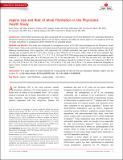| dc.contributor.author | Ofman, Peter | en_US |
| dc.contributor.author | Petrone, Andrew B. | en_US |
| dc.contributor.author | Peralta, Adelqui | en_US |
| dc.contributor.author | Hoffmeister, Peter | en_US |
| dc.contributor.author | Albert, Christine M. | en_US |
| dc.contributor.author | Djousse, Luc | en_US |
| dc.contributor.author | Gaziano, J. Michael | en_US |
| dc.contributor.author | Rahilly‐Tierney, Catherine R. | en_US |
| dc.date.accessioned | 2015-03-02T17:37:53Z | |
| dc.date.issued | 2014 | en_US |
| dc.identifier.citation | Ofman, Peter, Andrew B. Petrone, Adelqui Peralta, Peter Hoffmeister, Christine M. Albert, Luc Djousse, J. Michael Gaziano, and Catherine R. Rahilly‐Tierney. 2014. “Aspirin Use and Risk of Atrial Fibrillation in the Physicians' Health Study.” Journal of the American Heart Association: Cardiovascular and Cerebrovascular Disease 3 (4): e000763. doi:10.1161/JAHA.113.000763. http://dx.doi.org/10.1161/JAHA.113.000763. | en |
| dc.identifier.issn | 2047-9980 | en |
| dc.identifier.uri | http://nrs.harvard.edu/urn-3:HUL.InstRepos:14065360 | |
| dc.description.abstract | Background: Inflammatory processes have been associated with an increased risk of atrial fibrillation (AF), potentially allowing for preventive therapy by anti‐inflammatory agents such as aspirin. However, the effect of chronic aspirin on the incidence of AF has not been evaluated in a prospective cohort followed for an extended period. Methods and Results: This study was comprised of a prospective cohort of 23 480 male participants of the Physicians' Health Study. Aspirin intake and covariates were estimated using self‐reported questionnaires. Incident AF was ascertained through yearly follow‐up questionnaires. Cox's regression, with adjustment for multiple covariates, was used to estimate relative risk of AF. Average age at baseline was 65.1±8.9 years. During a mean follow‐up of 10.0 years, 2820 cases of AF were reported. Age‐standardized incidence rates were 12.6, 11.1, 12.7, 11.3, 15.8, and 13.8/1000 person‐years for people reporting baseline aspirin intake of 0, <14 days per year, 14 to 30 days per year, 30 to 120 days per year, 121 to 180 days per year, and >180 days per year, respectively. Multivariable adjusted hazard ratios (95% confidence interval) for incident AF were 1.00 (reference), 0.88 (0.76 to 1.02), 0.93 (0.76 to 1.14), 0.96 (0.80 to 1.14), 1.07 (0.80 to 1.14), and 1.04 (0.94 to 1.15) across consecutive categories of aspirin intake. Analysis of the data using time‐varying Cox's regression model to update aspirin intake over time showed similar results. Conclusions: In a large cohort of males followed for a long period, we did not find any association between aspirin use and incident AF. | en |
| dc.language.iso | en_US | en |
| dc.publisher | Blackwell Publishing Ltd | en |
| dc.relation.isversionof | doi:10.1161/JAHA.113.000763 | en |
| dc.relation.hasversion | http://www.ncbi.nlm.nih.gov/pmc/articles/PMC4310361/pdf/ | en |
| dash.license | LAA | en_US |
| dc.subject | Arrhythmia and Electrophysiology | en |
| dc.subject | aspirin | en |
| dc.subject | atrial fibrillation | en |
| dc.subject | epidemiology | en |
| dc.subject | risk factors | en |
| dc.title | Aspirin Use and Risk of Atrial Fibrillation in the Physicians' Health Study | en |
| dc.type | Journal Article | en_US |
| dc.description.version | Version of Record | en |
| dc.relation.journal | Journal of the American Heart Association: Cardiovascular and Cerebrovascular Disease | en |
| dash.depositing.author | Ofman, Peter | en_US |
| dc.date.available | 2015-03-02T17:37:53Z | |
| dc.identifier.doi | 10.1161/JAHA.113.000763 | * |
| dash.contributor.affiliated | Peralta, Adelqui | |
| dash.contributor.affiliated | Hoffmeister, Peter | |
| dash.contributor.affiliated | Ofman, Peter | |
| dash.contributor.affiliated | Djousse, Luc | |
| dash.contributor.affiliated | Albert, Christine | |
| dash.contributor.affiliated | Gaziano, John | |


